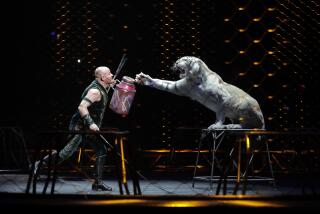THEATER : Aesop’s Fables Come to Life--2,500 Years Later
- Share via
Quick, name some ancient Greek fables.
Give up? For starters, try “The Tortoise and the Hare.” Also, “The Country Mouse and the City Mouse.” Both are familiar tales said to have been written by Aesop, a Greek slave who lived more than 2,500 years ago.
“We don’t realize how many of the stories we know are attributed to Aesop,” said Wendy Lehr, director of the Minneapolis Children’s Theatre Company’s production of “Animal Tales From Aesop,” which is on a national tour. The show will be staged Saturday at UCLA’s Freud Playhouse and Sunday at the Norris Theatre in Rolling Hills Estates.
The theatrical mix of dance, masks, Victorian costume and 19th Century-style music, for ages four and up, is a new work by the 30-year-old company, considered one of the nation’s leading theaters for children and families.
“The real inspiration” for the play, said Lehr, came from a children’s book by Barbara McClintock, a retelling of Aesop’s animal fables filled with the author’s illustrations.
“Her book is very theatrical,” Lehr said. “There are these wonderful animals on every page and then on the very last page, actors take off their masks and you see that they are performers.”
While the scenery, she said, “is brush stroke for brush stroke like McClintock’s,” it was the challenges of re-creating the author’s anthropomorphic drawings of animals that led the piece into the realm of dance theater. To match the drawings, the actors wore elaborate animal masks that made speech difficult. The actors “needed to extend gesture to really be understood. That extension went right into dance,” Lehr said.
To avoid staging merely a succession of unrelated stories, Aesop’s tales were woven together by playwright Marisha Chamberlain so that in a small country fair setting, Lehr said, “We follow the fortunes of several characters, while the narrator presents the introductions and the morals, and the Tortoise and the Hare continue their race.”
Music was an important factor in evoking the right tone for the period piece, said Lehr and composer Roberta Carlson.
Said Carlson: “When we first started discussing the show, Wendy said she was interested in making it an homage to the 19th Century and the roots of American musical theater. We decided to do it with wit and humor, not make it a ‘child’s guide to musical theater.’ ”
Prerecorded and performed by members of the St. Paul Chamber Orchestra, the score uses instruments to musically suggest each animal’s voice, from a “twitchy” flute for the mezzo-soprano Country Mouse to a French horn for the baritone Fox.
Lehr added that “some very clever turns in the piece” are designed to appeal to adults as well. “One of the best things we’ve been hearing about the show is that it plays across the ages.”
Just like Aesop.
“Animal Fables From Aesop,” 2 and 7 p.m. Saturday: UCLA, Freud Playhouse, (310) 825-2101; $11-$22. 3 p.m. Sunday: Norris Theatre, 27570 Crossfield Drive at Indian Peak Road, Rolling Hills Estates, Palos Verdes, (310) 544-0403; $18.
More to Read
The biggest entertainment stories
Get our big stories about Hollywood, film, television, music, arts, culture and more right in your inbox as soon as they publish.
You may occasionally receive promotional content from the Los Angeles Times.










